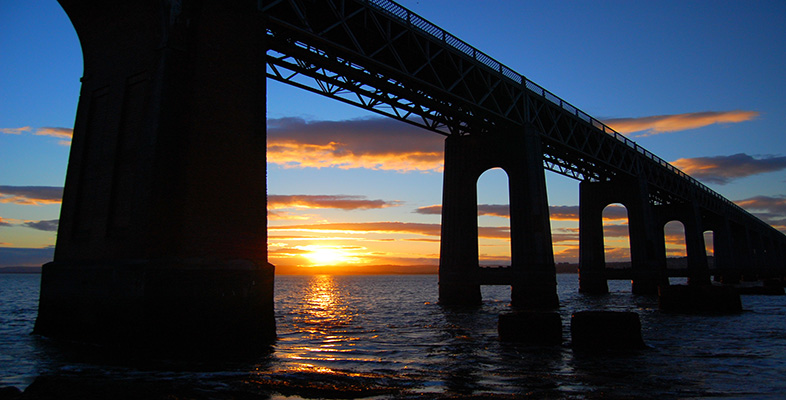3.4 Building the bridge
The contract for the bridge was won by the firm of Charles de Bergue, and a contract signed on 8 May 1871, whereby the contractor undertook to have the bridge ready for traffic in three years at a price of £217 000. In the event the bridge was opened on 31 May 1878, by which time it had cost £300 000.
Work started on the south bank of the Tay, with piers laid on to solid rock foundations. As the piers advanced into the estuary, foundations needed to be sunk onto the river bed, and caissons (cylinders of wrought iron) were lowered onto the bed, and the water extracted so that workers could excavate the bed itself.
As the alluvium was removed, the cylinder sank down to the bedrock, and was then filled with concrete and built up above water level to form the pier. A solid brick and masonry pier could then be constructed up to the level of the track. Unfortunately, the rock shelf on which the first 14 piers were built became deeper and deeper. A new method of building the piers was needed.
The original contractors were replaced by Hopkins, Gilkes & Co, although they kept the site manager, Arthur Groethe. The increasing depth of solid foundations was tackled by driving piles into the alluvium to give firm support for the piers, and the piers themselves were made much lighter.
Bouch changed the materials for the piers from solid brick to a cast-iron and wrought-iron space frame, a method he had used successfully in a previous bridge at Belah in the Pennines (see Input 7, linked below). The caisson on one such pier (no. 54) burst in August 1875, and six men were killed by the inrush of mud and water. By April 1876, construction had proceeded well with 76 of the 85 spans being built, so only 18 further spans were needed to complete the structure.
Click 'View document' below to open Input 7
View document [Tip: hold Ctrl and click a link to open it in a new tab. (Hide tip)]
Later, in February 1877, when the high girders were being lifted into position on top of the finished piers, there was another accident that should have served as a warning of the problem of high winds on the structure.
The two southernmost spans had been floated out on pontoons, and raised by hydraulic jacks ready to be lowered onto the pier heads. The girders were normally raised onto the piers at a low height, and the columns raised with the girders held above them by hydraulic jacks. They hung on metal pins supported by temporary columns five feet above the pier heads. The pins were moved into different holes until a girder was in place.
A gale suddenly sprang up as night approached, and at about 8.15 pm the girders were blown from their positions into the water below. The wind must have been strong, because temporary shacks in the girders used by the workers were blown away. One worker died, but the damage was repaired.
The bridge was first crossed by the directors of the NBR on 26 September 1877, and detailed tests conducted on its stability by Major-general Hutchinson in February 1878. He spent three days examining the bridge, finally testing its loading capacity with no fewer than six ballast engines running at various speeds across the structure. Vibrations were, he thought, not excessive, but he was not able to test for wind pressure. The bridge was opened to public traffic and a regular timetable implemented.
